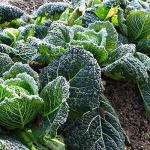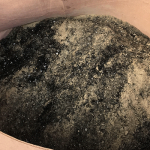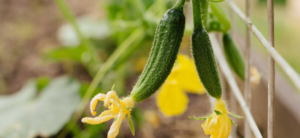
As winter approaches, you are likely wondering how to protect plants from frost. During these colder months, lots of gardeners either call it quits until springtime or bring their plants indoors.
Indoor growing is a great way to keep the garden going throughout winter, especially when using a grow tent and grow light. But, not everyone has the space for an indoor grow. Don't worry, all is not lost!
There are plenty of vegetables and plants you can grow during these tough, winter months. And, we have some tips on protecting your plants from frost. This winter, give some of these a try and let us know how it went!
What exactly is frost?
A “frost” doesn’t necessarily mean temperatures are below freezing. It doesn’t need to be cloudy or snowing for a frost to ruin your garden. In most cases, a frost occurs on calm, clear evenings. Cold air settles at the lowest point (the ground, where your plants are).
Ice crystals will start forming on your plants, which can disrupt water movement throughout the plant and dry out your plants. Chilling winds can make things worse, lowering temperatures further.
In some cases though, a wind can disperse warmer temperatures around your plant, helping them out.
What vegetables can I grow during cold winter months?

There are certain plants that you shouldn’t try to grow during winter. But, there are also plenty that can withstand cold weather!
The following vegetables are known to be extremely hardy, withstanding cold climates and harsh conditions.
If you want to try gardening in the winter months, you can't go wrong with any of these. Be sure to plant only the hardiest varieties of these vegetables.
- Spring Onions
- Mushrooms
- Garlic
- Lettuce
- Herbs
- Peas
- Broad beans
- Pak Choi
- Asparagus
- Spinach
Now, you can’t just plant these in December and hope they survive the winter. Frost and below-freezing temperatures can still damage, and even kill these veggies.
So, you are probably asking, “how do I protect my plants in the winter?” There are a number of methods we recommend.
How To Protect Your Plants From Frost
Protecting your plants from frost comes down to planning ahead and being vigilant of the forecast.
Some of these may not always be feasible, but there is always something you can do to protect your plants from harsh winter weather.
Strategically designing your garden to be frost resistant
You can set up your garden in a manner that minimizes the risk of frost damaging your plants. Because we know that frost settles at the lowest point, the easiest step is using a raised bed.
You can also set up your raised bed near a fence, wall, or bench. Especially if these structures are darker in color. They will absorb heat during the day, especially if they face the sun (south or west), and will radiate this warmth throughout the night to your plants.
This is just a small measure you can take before you plant anything to protect plants from frost.
Harden off seedlings indoors
Baby plants and seedlings have no business being outdoors in winter to begin with. Ideally, you would plant your garden towards the end of fall before temperatures get too low.
This way, they are strong enough to withstand the cold weather when it comes. Even still, the best way to start any garden is indoors. Our seed starting kits include everything you need to start any variety of plant indoors.
Then, once its developed ample root mass and hardened off, you can transplant them into a pot or your raised bed outdoors.
Cover plants before nightfall
The best way to actively protect plants from frost is by covering them up at night. Once the sun goes down, temperatures start to drop.
You can cover your plants up as the sun is going down to keep any warmth from the day trapped inside. This can protect them overnight when temperatures reach their lowest point.
What temperature do you need to cover your plants?
The temperature at which you need to cover your plants will vary based on the type of plant itself.
Certain vegetables can be damaged at higher temperatures than others, but to be safe, assume anything below 32 degrees Fahrenheit (freezing temperature) can be detrimental. Some gardeners even recommend covering up plants at 35 degrees or less.
What is the best way to cover plants from frost?

There are plenty of ways you can cover plants to protect them from frost, but some will be way more effective than others.
It doesn’t have to be fancy, you can simply put some bamboo sticks or stakes around your plants (right around their height) and cover them with whatever you have. Here are some of the best options:
- Bed sheets or blankets
- Drop Clothes
- Garden blankets
- Frost cloths
If you don’t have any stakes or covers, and your plants are smaller, you can use an inverted flower pot or bucket, or even milk jugs with the bottoms cut out.
We highly recommend using a frost cloth or a garden blanket. These are specifically designed for this purpose and will perform much better than bed sheets or blankets from your house. The biggest advantage they have is being waterproof, lightweight, and breathable, without allowing heat to escape.
The idea with covering your plants isn’t to strangle them - you just want to create a drape over them. This will allow heat to rise up from the ground and gather around the top of the tarp.
If you wrap around your plant and tie it off, heat won’t be able to get into the cover.
Can you use a tarp to cover plants?
We do not recommend using plastic tarps or trash bags to cover your pants. These will not hold in heat as well as cotton options.
Will a covered porch protect plants from frost?
If its your only option, a covered porch will be slightly warmer than leaving plants in your garden. But, if you have potted plants and you're trying to move them somewhere warmer, there are better options.
Consider the garage, a sunroom, an entryway, or anywhere that has hardwood.
Can I leave plants covered all day?
If the temperatures are going to be below freezing all day, then you may want to leave plants covered. But, let's assume its just a light frost. In the morning when the sun comes out, you should remove the covers.
This way, you can recapture ground heat, and you'll be able to thaw your plants out and liven them up. Then, around sundown, you can cover your plants again to protect them from the next frost.
Warm your plants with water jugs
If you want to take things a step further, you can cover your plants like we just recommended, but use water jugs to further increase heat within the cover! Here is what you need to do:
Fill water jugs (however many you use is up to you), and allow them to sit in the sun all day so they get warm. and then before sundown when you cover your plants, place the jugs near your plants (under the cover, of course). They will slowly release heat throughout the evening.
Water before a frost
It sounds counterintuitive, but many gardeners suggest that watering your plants before cold weather may help combat frost.
You would think the opposite to be true, and that the water would freeze the plants…so what does the science say? Should you water potted plants before a freeze?

As it turns out, watering your plants before a freeze can grant them some level of protection.
The wet soil will release moisture throughout the night, increasing not just humidity, but temperature as well. On top of that, moist soil hold more heat than dry dirt.
Bring potted plants indoors
The easiest way to protect plants from frost is by bringing them indoors where it's warm. If you planted them in a raised bed or right in the ground, this probably won’t work. You obviously don’t want to pull them out of the ground.
But, if they are in pots, its super easy to just bring them in the garage, an entryway, etc. Put down saucers first so you don’t get soil or dirt anywhere.
If you have grow lights, and better yet, a grow tent to match, you can just keep your plants indoors for the winter. Indoor growing is the easiest way to protect your plants from frost, since your house will be nice and warm.
If indoor growing sounds interesting to you, grab a grow tent kit and get started!
Parting advice on how to protect plants from frost
There are a few ways to protect your plants from frost, some will work better than others. In summary, your best bet is to plan ahead and design your garden strategically, and only grow very hardy plants that are known to withstand freezing temperatures.
You can cover your plants with frost blankets, water them before a frost, use water jugs, and do all sorts of things.
But, if you really want to keep growing through winter and don’t want to jump through hoops to keep your plants alive, just grow indoors.
Just about everything you grow outdoors can be grown indoors, and when temperatures are freezing and there are lots of cloudy days, your plants aren’t going to flourish anyways.
Grab an indoor grow tent kit and start planting today!














